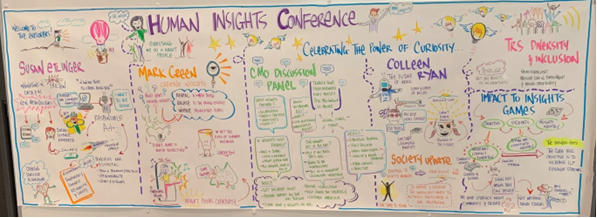I was lucky enough to attend the Human Insights conference in August 2022 (#HUMIN22) and the headline act was Louis Theroux. I felt excited by the prospect of listening to this master conversationalist (and potentially even meeting him).
But my expectations were quickly tempered when I realised that we’d be listening to him virtually. He wasn’t available to attend in person, but his virtual session was still impressive. We know him best through the screen, and he has presence which was engaging (like in his BBC documentaries which he calls ‘programs’).
What struck me was his ability to relate to those in our industry. He acknowledged that journalists and insights professionals have complementary skills like asking questions and listening. He also demonstrated this through his use of storytelling – an important skill in both crafts.
He describes interactions with others as conversational encounters. The term 'interview' doesn’t sit well with him because he doesn’t want the experience to feel formal or like an interrogation. He mentioned that he tries to avoid sitting down while doing interviews.
This is why you often see him walking and talking with someone or doing an activity together on his programs. He shared some examples like chopping wood with someone while talking to them about the new world order and how civilisation is going to collapse. Or having a discussion with a porn performer while they were getting changed.
One exception to his rule about avoiding sitting down is going for a long drive in the car because he believes “the truth comes out in the car.”
It got me thinking about how we might apply this to our work.
Firstly, we use the term ‘depth interview’ in qualitative research and it sounds very formal. This could potentially be off-putting or intimidating to participants. Perhaps we should re-phrase this to an ‘in-depth conversation’.
And what about the setting? Often when we meet participants in a face-to-face context, it’s in a formal setting like a meeting room. We should consider having more walking discussions, or even a conversation while driving in a car.
Obviously, this is not always possible but what I learned is by reframing our thinking from ‘how do we do this’ to ‘how can we make our participants feel more comfortable’ then there is a good chance we’ll have a more insightful conversation.
Further to this point, the end goal of any journalistic or research engagement should always be to tell a story, which I believe a conversational encounter helps to achieve. But how we communicate what we’ve learned is critical.
Another valuable insight I heard at the conference which relates to communication was the power of visual storytelling. We were told by another keynote speaker, Simon Banks, that we remember 65% of what we see but only 10% of what we read.
Here’s a great example. He summarised the first day at #HUMIN22 by using imagery, colour and minimal text in this visually appealing piece of artwork. He was doing this while people presented throughout the conference and even showed us how to rediscover our childhood artistic flair through drawing and apply this to our work.

Regardless of our drawing capabilities, the message was clear: we should emphasise creating great imagery to tell our stories, which is likely to engage our audience.
I’ve attended many conferences held by The Research Society and always looked for key learnings to enhance my research skills. But having joined SenateSHJ this year, I was observing through a slightly different lens – insight driven communications. These were just some of the valuable lessons I learnt.
I’d welcome any opportunity to discuss these and other key learnings with you.